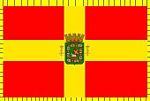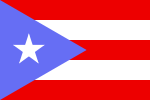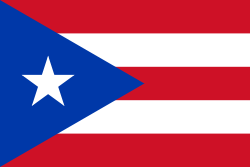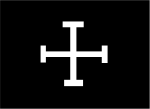Flag of Puerto Rico
The flag of Puerto Rico consists of five equal horizontal bands of red (top and bottom) alternating with white; a blue isosceles triangle based on the hoist side bears a large, white, five-pointed star in the center.
Though there are specific shades of red and blue that are used for the flag, some flag-makers make slight modifications. Specifically, the shade of blue used on the flag may correspond to the flag-flyer's political beliefs. Flags made by pro-independence groups use a sky light blue, while pro-commonwealth and pro-statehood groups use darker shades (as on the U.S. flag). The 1952 and current version employed by the government uses a dark-blue shade
Contents |
First flags in Puerto Rico

The introduction of a flag in Puerto Rico can be traced to when Christopher Columbus landed on the island's shore and with the flag appointed to him by the Spanish Crown claimed the island, which he named "San Juan Bautista," in the name of Spain. Christopher Columbus wrote in his logbook that on October 12, 1492 he picked the Royal Flag, and his captains two flags which the Admiral carried in all the ships as Ensign, each white with a green cross formy couped addorsed by old Gothic letters 'F' and 'Y', both green and crowned with golden, open royal crowns, for Ferdinand II of Aragon and Ysabel (Isabel I). The conquistadores under the command of Juan Ponce de León proceeded to conquer and settle the island, They carried as their military standard the "Spanish Expedition Flag". After the island was conquered and colonized, the official flag of the colony was the flag of Spain.[3]
Historical flags of Puerto Rico

Once the Spanish armed forces established themselves on the island they began the construction of military fortifications such as La Fortaleza, Fort San Felipe del Morro, Fort San Cristobal and San Geronimo. The Spanish Army designed the "Burgundy Cross Flag" and adopted it as their standard. This flag flew wherever there was a military installation.
The independence movement in Puerto Rico gained momentum with the liberation successes of Simon Bolivar and José de San Martín in South America. In 1868, local independence leader Ramon Emeterio Betances urged Mariana Bracetti to knit a revolutionary flag using the flag of the Dominican Republic as an example. She knitted the flag with a yellow star in the left upper corner. The "Revolutionary Flag of Lares" was used in the short-lived rebellion against Spain in what became known as El Grito de Lares (The Cry of Lares)[4]
In 1873, the Spanish crown issued a new colonial flag for Puerto Rico. The new flag resembled the flag of Spain but with the coat of arms of Puerto Rico in the middle. This flag was used on the island until 1898, the year that the island became a possession of the United States under the terms of the Treaty of Paris (1898) as the aftermath of the Spanish-American War.
|
|
||||||||
 |
 |
 |
||||||
| Burgundy Cross Flag (Spanish military flag) | 1868 Lares revolutionary flag | Spanish Colonial Flag (1873-1898) | ||||||
 |
 |
 |
||||||
| 45-star American flag, the first U.S. flag flown in Puerto Rico (from 1898-1952 the American flag was the only one permitted in Puerto Rico) |
Light blue triangle Puerto Rican flag of 1892 | Dark blue triangle Puerto Rican flag (1952–Present) | ||||||
History of the Flag of Puerto Rico
Some sources document Francisco Gonzalo Marin with presenting a Puerto Rican flag prototype in 1895 for adoption by the Puerto Rican Revolutionary Committee in New York City. Marín has since been credited with the flag's design. However, Antonio Vélez Alvarado probably deserves the credit. On June 12, 1892, Vélez was at his apartment at 219 Twenty-Third Street in Manhattan, when he stared at a Cuban flag for a few minutes, and then took a look at the blank wall in which it was being displayed. Vélez suddenly perceived an optical illusion, in which he perceived the image of the Cuban flag with the colors in the flag's triangle and stripes inverted. Almost immediately he visited a nearby merchant, Domingo Peraza, from whom he bought some crepe paper to build a crude prototype. He later displayed his prototype in a dinner meeting at his neighbor's house, where the owner, Micaela Dalmau vda. de Carreras, had invited José Martí as a guest. Martí was pleasantly impressed by the prototype, and made note of it in a newspaper article published in the Cuban revolutionary newspaper Patria, published on July 2 of that year. Acceptance of the prototype was slow in coming, but grew with time. Marín, who decided to have a proper flag sewn based on the prototype, presented the new flag's design in New York's "Chimney Corner Hall" a gathering place of independence advocates two years later. The flag "Puerto Rican Flag" (with the light blue triangle) soon came to symbolize the ideals of the Puerto Rican independence movement[5].
It should be noted that some people believe that Manuel Besosa was the designer, based on a letter written by his daughter. The flag was banned by the Spanish crown and later by the American insular government. The flag consists of five stripes that alternate from red to white. Three of the stripes are red, and the other two are white. To the left of the flag is a light blue triangle that houses one white five-pointed star. Each part of this flag has its own meaning. The three red stripes represent the blood from the brave warriors. The two white stripes represent the victory and peace that they would have after gaining independence. The white star represented the island of Puerto Rico. The blue represents the sky and blue coastal waters. The triangle represents the three branches of government.[6]

On December 10, 1898, Puerto Rico was annexed by the United States under the terms of the Treaty of Paris of 1898 as a result of the Spanish-American War. From 1898 to 1952 it was considered a felony to display the Puerto Rican flag in public; the only flag permitted to be flown on the island was the flag of the United States[7] During the Jayuya Uprising of 1950, members of the Nationalist party placed the Puerto Rican flag on top of the town hall; the flag was later taken down by a military soldier.
In 1948, Puerto Ricans were permitted to elect a governor. The newly elected governor Luis Muñoz Marín and his administration adopted the Marín version of the Puerto Rican flag in 1952, in which the triangle was a dark blue resembling that of the flag of the United States, and proclaimed it the official national flag of Puerto Rico.[8][9][10]
Municipal flags of Puerto Rico
Each of the municipalities of Puerto Rico, including the islands of Culebra and Vieques, have adopted a flag which represents the region and its people. The colors and designs vary. Some flags contain a coat of arms or images of an object associated with the region, such as a bird, animal, or crop. In the case of Lares the flag adopted was the "Revolutionary Flag of Lares" with the yellow star changed to white. Caguas is the only city whose barrios have their own flags.[11]
Many of the municipal flags of Puerto Rico pay tribute to the Cacíques of the Taino tribes (the native Puerto Rican tribe) who ruled the island before the arrival of the Spaniards. The flag of Utuado for example has a Taino Sun in honor of the Supreme Taino Cacique Agüeybaná whose name means "The Great Sun". Other flags, such as San Germán's contain a mural crown. The crown pays tribute to the local caciques who ruled the area.
Flags of the municipalities of Puerto Rico
Adjuntas |
Cidra |
Lajas |
Rio Grande |
Aguada |
Coamo |
Lares |
Sabana Grande |
Aguadilla |
Comerio |
Las Marias |
Salinas |
Aguas Buenas |
Corozal |
Las Piedras |
San Germán |
Aibonito |
Culebra |
Loiza |
San Juan |
Añasco |
Dorado |
Luquillo |
San Lorenzo |
Arecibo |
Fajardo |
Manati |
San Sebastián |
Arroyo |
Florida |
Maricao |
Santa Isabel |
Barceloneta |
Guánica |
Maunabo |
Toa Alta |
Barranquitas |
Guayama |
Mayagüez |
Toa Baja |
Bayamón |
Guayanilla |
Moca |
Trujillo Alto |
Cabo Rojo |
Guaynabo |
Morovis |
Utuado |
Caguas |
Gurabo |
Naguabo |
Vega Alta |
Camuy |
Hatillo |
Naranjito |
Vega Baja |
Canóvanas |
Hormigueros |
Orocovis |
Vieques |
Cataño |
Humacao |
Patillas |
Villalba |
Carolina |
Isabela |
Peñuelas |
Yabucoa |
Cayey |
Jayuya |
Ponce |
Yauco |
Ceiba |
Juana Diaz |
Quebradillas |
|
Ciales |
Juncos |
Rincón |
Political flags of Puerto Rico
Political flags in Puerto Rico are usually displayed in public during rallies, meetings, or parades in show of political strength and unity. The three main political parties of Puerto Rico are the New Progressive Party, which favors statehood and whose flag has a palm tree; the Popular Democratic Party of Puerto Rico, whose flag has an image of a Puerto Rican "jibaro" (farmer); and the Puerto Rican Independence Party, whose flag has a white cross symbolizing Christianity and purity, on a green background which symbolizes hope. The Puerto Rican Nationalist Party flag was usually displayed by the Cadets of the Republic, also known as the Black Shirts (Camisa Negras) because of their black shirt and white trousers uniform. On occasions the Nationalists would also carry the Puerto Rican flag with the light blue triangle, which was outlawed.
Another political flag is that of the Boricua Popular Army, also known as Los Macheteros or F.A.L.N., an underground pro-independence group which believes and has often resorted to the use of violence.[12]
|
|
||||||||
 |
 |
|||||||
| Puerto Rican Nationalist Party (Spanish: Partido Nacionalista Puertorriqueño) founded 1922 | Popular Democratic Party of Puerto Rico (Spanish: Partido Popular Democrático de Puerto Rico) founded 1937 | |||||||
 |
 |
|||||||
| Puerto Rican Independence Party (Spanish: Partido Independentista Puertorriqueño) founded 1946 | New Progressive Party of Puerto Rico (Spanish: Partido Nuevo Progresista de Puerto Rico) founded 1967 | |||||||
Sports flags of Puerto Rico
The standard carried by Puerto Ricans at international sports events, such as the Olympics, Pan American Games, Central American and Caribbean Games, and the World Cup of Baseball, is the Puerto Rican flag. However, various sports associations have adopted flags which are also used during sports events. Prior to the adoption of the Puerto Rican flag, Puerto Rico competed under both the US flag and a special white banner containing the seal.
See also
- Coat of arms of Puerto Rico
Notes
- ↑ CIA The World Fact Book, Retrieved Oct. 21, 2007
- ↑ Bandera de Puerto Rico - gobierno.pr, Retrieved Oct. 24, 2008
- ↑ Christopher Columbus' Flags 1492
- ↑ Peres Moris, José, Historia de la Insurrección de Lares, 1871
- ↑ Dávila-Dávila, Ovidio, Antonio Vélez Alvarado, amigo y colaborador consecuente de Martí y Betances, pp. 11-13.
- ↑ Puerto Rico
- ↑ Photos of the Jayuya Uprising
- ↑ Flag of Puerto Rico
- ↑ Welcome to Puerto Rico - Flag of Puerto Rico
- ↑ National Flags
- ↑ Utuado, Puerto Rico
- ↑ Political Flags of Puerto Rico
External links
- Puerto Rico at Flags of the World
- Puerto Rico flags at Vexilla mundi
- tribal nation flag of the Jatibonicu Taino Indians of Borikén
|
|||||||||||
|
|
|||||||||||||||||||||||
|
||||||||||||||
